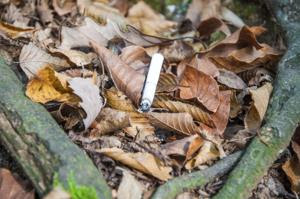"Life goes on though, and fires are not unnatural"
Margarethe Brummermann
 |
| Image - CNN |
 |
| Annimated Graph - USA Today |
The quote at the top of the post is from Margarethe Brummermann, Biologist from Dortmund Germany who resides in the Tucson area. She had written a post about Mount Lemmon which towers above Tucson to the north. I made a comment on her page about how my wife and I had driven up to Mount Lemmon last year May 2016 and how sad we were to see so much of the forest destroyed by wildfires. I made mentioned how I had first visited Mount Lemmon back in the late 1970s and there was hardly ever a scene where wildfire had damage anything. There was always the occasional snag here and there, but forests and even the high desert scrub were always able to recovery properly. That has all changed now. But her reply to me was simply, "Life goes on though, and fires are not unnatural." Her viewpoint is reflective of most all fire ecologists who champion fire as natural, yet often times have a hard time differentiating between human (especially if Native American) and lightning caused fires. Earlier this year, Fire Ecologist, Jennifer Balch, and other researchers revealed that 84% of all wildfires are human caused. Oh, but it get's even worse. They found that the actual figure for California, Oregon, Washington and on up to British Columbia in Canada is actually a figure at 90% human caused. So it question begs, is that something we should consider natural or unnatural ??? I only ask because humans today are considered unexceptional and nothing more than animals if you read the latest scientific literature on the subject. Don't get me wrong here, I don't believe anything as asinine as that. But it does reveal how an ideologically driven worldview can infect and distort the practice of Science and create ignorance as opposed to understanding. Historically, the majority of wildfires on Mount Lemmon have had a human cause. This has also exacerbated theproblem of human introduced non-native, Buffel Grass, to invade clear up through the Saguaro Forests into the mid-elevation ranges of the Mount Lemmon. Here is that interesting finding regarding the human 90% origined cause of most wildfires at present.
Science Magazine: "Who is starting all those wildfires? We are"
 |
| Aaryn Olsson, University of Arizona |
Last year when we traveled up the Mount Lemmon highway, we were greeted all along the way by an overwhelming sea of Buffelgrass which blanketed all areas of the Santa Catalina Mountains near Tucson. Researchers say warming temperatures and fewer winter freezes are helping the invasive plant spread, posing a threat to saguaro cactuses and other native plants. The Tucson Sentinel even had an article with a chilling title, "Arizona without Saguaros? As climate warms, desert's future uncertain." The Saguaros are such an iconic symbol of Arizona and the Sonoran Desert. But they cannot take wildfire. They have no protection against it. I can't hardly imagine them being eliminated permanently.
 |
| Grant Martin/Cronkite News Service |
Bromus tectorum, an invasive species commonly called “cheatgrass,” grows in an area of the Coconino National Forest burned in a 1996 wildfire. I strongly dislike Cheatgrass. This is the invasive noxious weed whose stickers you have to pull out of your socks every so often down the trail when you go on a hike.
 |
| Grant Martin/Cronkite News Service |
Researchers say this area of the Coconino National Forest, which burned in 1996, is decades away from returning to its native state, if it ever does. They say rising temperatures have weakened trees, raising the potential for devastating wildfires that will open the door to invasive species. Don't expect recovery anytime soon.
 |
| Image - Getty Images |
I remember reading the fire ecology literature some time back in 2006. There was an account written by Arizona Historian Marshall Trimball of the old west in New Mexico, when a Cavalry Officer was complaining to his superiors about his men smoking cigarettes and dropping them along the trail as they all rode horseback. The problem was they were starting grass fires from their careless bad habit. Of course this was in the 1800s, when Indians still existed and practiced their ecological conservation with fire. Yet hsitorical writings from the 1800s relay that they used fires to war against their enemies. Not exactly eco-friendly. I know, it destroys the narrative. This 1800s is the time period for celebration for most fire ecologists who champion how natural the forested ecosystems all were back then because of Indians. But as I've questioned this before, if fire ecologists were looking at the world back then and telling us how natural wildfire played in ecology of all plant community systems, how did they reconcile white European Soldiers starting fires with their cigarette butts ? Was that a good thing for Nature ? How did this factor into their research of what was good for the plant community environment ? Native Americans generally get a free pass on why they started fires and they really shouldn't. See the post, Dances With Myths. But now what about the white man back then ? Today there is a movement to down grade human beings as not being so exceptional. Mankind is now being considered nothing more than animals equal to everything else. Does this now mean that the research on wildfire causes being 84% human fault provide us a new designation of the term, "Natural" ??? 😲 Would it mean that humans carelessly throwing down a cigarette butt today should now be considered perfectly normal behaviour ??? 😟 We seem to be living in a time period of redefining everything from it's historical normalcy.
But what about all those heavy Rains 🚿 ??? Didn't things get better ??? 🌳
 |
| Image - Pismo Hotels |
This year's rainy season of 2017, California experienced one of those unprecedented rainy seasons, after four years of serious intense drought. But everyone cheered Hooray 🙌 and celebrated with waving pom poms that all was well again in California again. The drought was now over, or was it. Indeed, heavy rains came, even to the point of major flooding events up and down the state. While there were some very clear catastrophic negatives, one of the great joys of all that rain brought out a spectacular display of wildflower blooms. Starting in early March, flowers popped up all across Southern and Central California and produced some seriously spectacular scenery. The photo opportunity didn't go unnoticed nor wasted by many of the non-profit eco-activist groups hoping to cash in on a fund raising opportunity by posting pics on their website's & Social Network pages indicating that Nature seemed to have rebounded from the jaws of death. Or you know, that old Jurassic Park Cliche (a phrase or opinion that is overused and betrays a lack of original thought) "Life found a way." Except that things really were'nt all that rosey as they advertised. First, some of the people were a little too anxious about getting out there first with they cameras. Then it appears that much of the water came in so fat and furiously, that most of it raced back to the Pacific Ocean like a bullet train. Some water did fill up many of the State's reservoirs, but the surrounding landscape didn't have great percolation into the hills and mountains.
 |
| Roger C. Bales |
Look, I refuse to celebrate and worship fire as some kind of animist Creator the way most fire ecologists worship it. Yes fire has always existed and is a reality in the natural world and can be used as an excellent tool for correcting problems along with other management tool like thinning forests in any ecosystem if done properly. And I've actually done that. But mostly humans have misused and abused fire, even the so-called experts. Prior to 2006 I never read much of anything about the science discipline of fire ecology, although I worked with people in the US Forest Service back in the 1980s who did prescribed burns. But I've also fought them tooth and nail against many of their ideas which are complete failures when it comes to reforestation techniques. Take the Fire Ecologist insistence that fire is needed for the wild seed germination. For example, Tecate Cypress is one of those trees in which Fire Ecologist have insisted for decades needs fire in order to propagate itself. Prior to reading their literature, in all my 30+ years of outdoors exploration experience and seed collecting, I never found this to be true of Tecate Cypress. There are numerous circumstances under which the seed is dispursed or spread and germinates fine without the need of fire within old growth chaparral which hasn't burned in a couple of hundred years. Same with Arizona Cypress. Fire is not always necessary, but you cannot tell them this. Science is not supposed to be about working in a Lab and venturing outdoors once in a while on a couple token field trips to make the research look legit. You have to live outdoors with nature. Look, I am not credentialed. I have no alphabet soup initials behind my name, nor some fancy coveted title before my name. Thank God. That allows me the freedom of not being shackled to a dogma and infected by the worldview biases and flawed presuppositions common to the Scientific Orthodoxy's industrial business model. I'm just one of 6+ billion people on Earth subjected to the negative consequences of inept decision making from a world leadership which has been weighed in the scales and found deficient. But it's allowed me to view things from a periferal viewpoint as opposed to tunnel-vission.
 |
| Image from H. Armstrong Roberts/ClassicStock |
BTW, here is an example of Prairie Fire and a Steam Locomotive, 1872, whose smoke stacks belched cinders (pre-spark aresters) and started numerous prairie and forest fires in the days of the old west. Wonder if that was ever factored into the fire ecologist fire is a creator research ??? This video below from China's still operational locomotives servicing coal mines just question begs, "Do fire ecologists who insist that fire is a natural necessary healthy component of plant ecosystems ever factor in human stupidity as part of that natural component mechanism ???" I know I know, because the Indians did it! 😕
Fire sparks of Steam in Sandaoling Coal Mine Railway China
References I've written for seed germination, not entertainment, just practical real world application and fun:




No comments:
Post a Comment
Thanks for visiting and for your comments!
I will try to respond to each comment within a few days, though sometimes I take longer if I'm too busy which appears to be increasing.